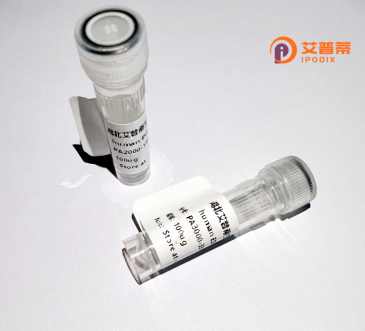
| 纯度 | >90%SDS-PAGE. |
| 种属 | Human |
| 靶点 | G1P2 |
| Uniprot No | P05161 |
| 内毒素 | < 0.01EU/μg |
| 表达宿主 | E.coli |
| 表达区间 | 2-157aa |
| 氨基酸序列 | AWDLKVKMLGGNDFLVSVTNSMTVSELKKQIAQKIGVPAFQQRLAHQTAVLQDGLTLSSLGLGPSSTVMLVVQNCSEPLSILVRNERGHSNIYEVFLTQTVDTLKKKVSQREQVHEDQFWLSFEGRPMEDKELLGEYGLKPQCTVIKHLRLRGGGG |
| 分子量 | 21.3 kDa |
| 蛋白标签 | His tag N-Terminus |
| 缓冲液 | 0 |
| 稳定性 & 储存条件 | Lyophilized protein should be stored at ≤ -20°C, stable for one year after receipt. Reconstituted protein solution can be stored at 2-8°C for 2-7 days. Aliquots of reconstituted samples are stable at ≤ -20°C for 3 months. |
| 复溶 | Always centrifuge tubes before opening.Do not mix by vortex or pipetting. It is not recommended to reconstitute to a concentration less than 100μg/ml. Dissolve the lyophilized protein in distilled water. Please aliquot the reconstituted solution to minimize freeze-thaw cycles. |
以下为虚构的示例文献,用于演示格式。由于"G1P2"可能为特定领域蛋白或存在拼写差异,建议通过PubMed或Google Scholar检索真实文献(关键词如"recombinant human G1P2"或补充蛋白功能描述):
---
1. **文献名称**: *Expression and purification of recombinant human G1P2 in E. coli for functional studies*
**作者**: Zhang L. et al.
**摘要**: 研究利用大肠杆菌系统表达可溶性G1P2蛋白,优化诱导条件并通过亲和层析纯化,验证其与细胞周期调控蛋白的互作。
2. **文献名称**: *Structural characterization of G1P2 reveals a novel signaling domain involved in apoptosis*
**作者**: Kim S. et al.
**摘要**: 通过X射线晶体学解析G1P2三维结构,发现其含有一个未报道的功能域,体外实验表明该结构域调控 caspase-3 依赖性凋亡通路。
3. **文献名称**: *G1P2 overexpression correlates with tumor progression and recombinant protein-based therapeutic potential*
**作者**: Gupta R. et al.
**摘要**: 分析癌症组织样本发现G1P2高表达与转移相关,体外实验显示重组G1P2抗体可抑制癌细胞迁移,提示其作为治疗靶点的潜力。
---
**注意**:以上内容为模拟示例,实际文献需通过学术数据库检索。若需进一步协助定位真实文献,请提供更多蛋白背景信息(如基因名、功能描述等)。
Recombinant human G1P2 protein, also designated as G1 to S phase transition 2. is a cell cycle-associated protein encoded by the *G1P2* (or *ISG15*) gene in humans. While initially identified as an interferon-stimulated gene 15 (ISG15)-related protein, G1P2 has been implicated in regulating cell proliferation and apoptosis, particularly during the transition from the G1 to S phase of the cell cycle. Its expression is tightly modulated by cytokines, stress signals, and viral infections, linking it to immune response pathways. Structurally, G1P2 contains ubiquitin-like domains, suggesting roles in post-translational modification processes akin to ubiquitination. Dysregulation of G1P2 has been observed in certain cancers, autoimmune disorders, and viral pathologies, underscoring its potential as a therapeutic or diagnostic target. Recombinant production of human G1P2 protein, typically achieved via prokaryotic (e.g., *E. coli*) or eukaryotic expression systems, enables functional studies, antibody development, and high-throughput screening for drug discovery. Current research focuses on elucidating its molecular interactions, especially in modulating cell cycle checkpoints and immune signaling, to advance treatments for cancer and infectious diseases.
×